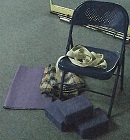Somatic Movement Re-Education
Our body typically responds to stress and trauma in our daily lives through involuntary and unconscious reflexes. When these reflexes are continually triggered, they create habitual muscular contractions which we cannot voluntarily release. This leads to sensory motor amnesia (SMA), where we lose the ability to control the muscles or muscle groups involved in these adaptive reflexes. SMA presents as limited range of motion, pain or dysfunction.
SMA occurs in the nervous system and is a learned adaptive response which means it can be un-learned through re-education of the sensory motor loop.
Thomas Hanna, the founder of somatic movement recognized that the body typically responds to stresses through three common reflexes. We are usually a blend of all three of these reflexes but one will be dominant.
The Red Light/Startle Pattern
a natural response that occurs in all animals as a reflexive withdrawal from actual or imagined danger/stress
presents as strong forward flexion and internal rotation of limbs
modern activities such as driving, long hours working at a computer, texting, and poor postural habits can lead to a slumped posture with rounded shoulders and spine.
Common Complaints associated with the Red Light Reflex
neck and shoulder pain, TMJ, Tinnitus, thoracic outlet syndrome, carpal tunnel, upper back pain, breathing problems, hip and knee problems, collapsed arch, depression and anxiety.
The Green Light/Landau Pattern
the call to action reflex present in the first year of life which allows for children to begin to lift the head, and leads to the ability to crawl and then walk. This reflex can become habituated in our on the go fast paced lives and can lead to pain dysfunction
presents as strong contraction of the posterior muscles of the back and external rotation of the limbs
Common Complaints associated with the Green Light Reflex
low back pain, SI joint pain, lower extremity pain, plantar fasciitis, neck pain, degenerative disc disease, stress and anxiety.
The Trauma Reflex Pattern
a protective muscular response to severe injury, accidents or trauma. An attempt to pull away or avoidance of pain
can also be a compensation pattern developed during a period of recovering from a minor injury such as a fall, a cast on one foot, or can occur from one sided habituated postures and activites
presents as the muscles of the waist and hip on one side contract causing lateral flexion of the spine and rotation of the torso
Common Complaints associated with the Trauma Reflex
One sided pain, SI joint pain, sciatica, scoliosis, breathing issues, bursitis, carpal tunnel, frozen shoulder, tennis elbow, uneven gait, hip and knee pain
How to Release These Reflex Patterns
Thomas Hanna discovered that to re-educate these neuromuscular reflexes, you need to provide new input to the sensory motor system, simply stretching or practicing relaxation techniques will not release the muscular contractions. By incorporating sensory motor awareness the higher levels of the nervous system receive new input and create new or reawaken neuropathways to teach the muscle or muscle groups to release the contraction. This new input is received first by the somatic principals and a blending of therapeutic exercise and classical yoga asana.
Learn to Pay Attention
nourish self awareness through the breath and sensing
pay attention to the process and the internal sensations
break movements into smaller parts and move slowly – the slower you go the more you will perceive
Build Better Habits through the use of therapeutic movement and classical yoga asana
learn to be efficient with movement patterns
build awareness and then self correct – radiate support from your centre(spine) out to your limbs
go from simple movement to complex movement
add load gradually
Let your body experience the freedom to
move well, breath well, live well



 Regardless of the conditions or limitations you may have or the activities you do, we all can move
Regardless of the conditions or limitations you may have or the activities you do, we all can move 